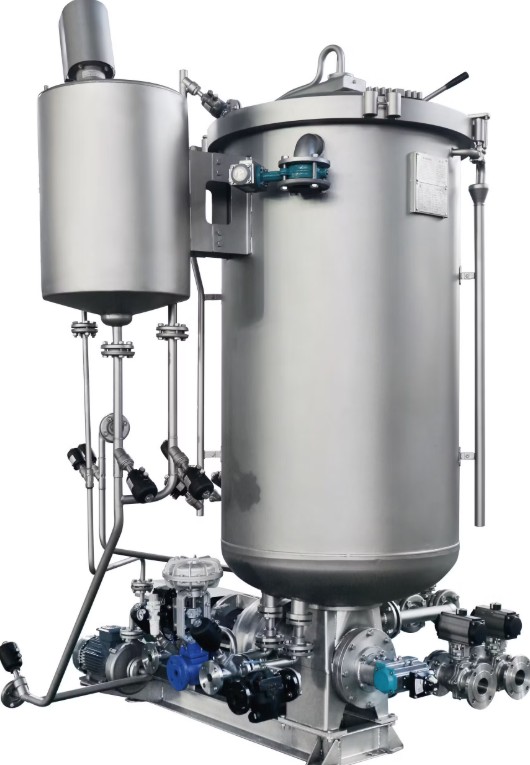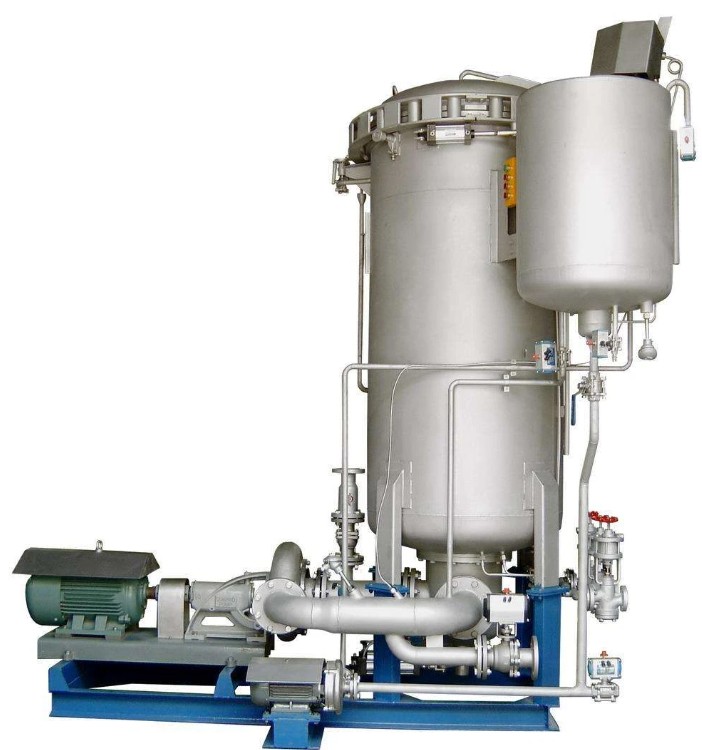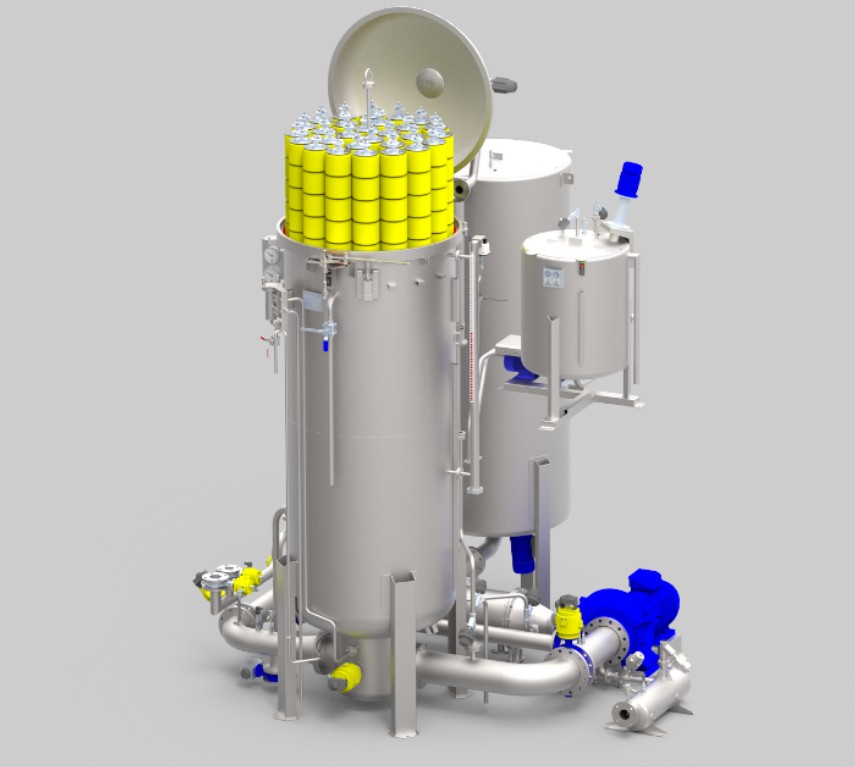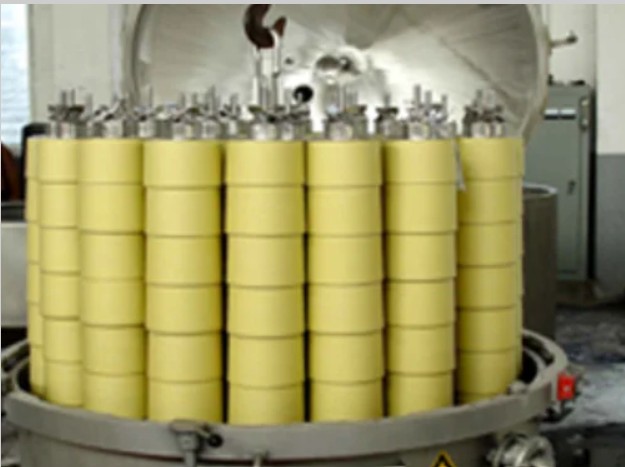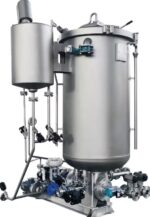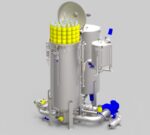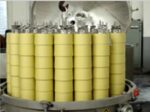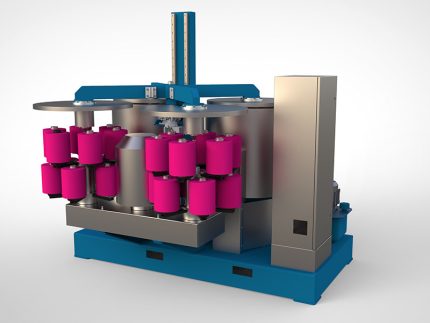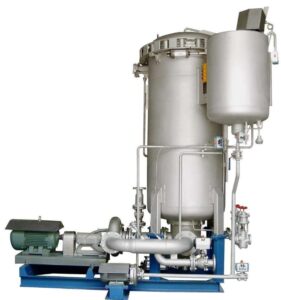Cone yarn Dyeing machine
$0.00
Cone Yarn Dyeing Machine

Cone Yarn Dyeing Machine
A Cone Yarn Dyeing Machine is an industrial machine used for dyeing yarn wound on perforated cones. It allows dye liquor to flow through the yarn packages under pressure and temperature, ensuring deep and uniform color penetration. A Production Cone Yarn Dyeing Machine is a large-capacity, high-efficiency machine designed for dyeing yarns wound on cones in bulk. It’s essential in commercial textile operations where consistent shade, penetration, and process repeatability are critical.
Purpose of Cone Yarn Dyeing Machine:
To dye large batches of yarn cones efficiently and consistently.
Key Components:
Dyeing Vessel: – A vertical or horizontal pressure vessel made of stainless steel (SS 316/304), designed to withstand high pressure and temperature.
Yarn Carrier (Spindles): – Holds multiple cones arranged on perforated spindles allowing dye to pass through.
Circulation Pump: – Forces dye liquor through yarn in inward and/or outward flow for thorough penetration.
Heat Exchanger: – Heats dye bath using steam or thermal fluid, with precise control.
Control System (PLC): – Fully automated for setting temperature profile, flow direction, timing, and rinsing cycles.
Liquor Tanks & Valves: – For preparation, dosing, and circulation of dyes, chemicals, and water.
Working Cycle:
Loading: Cones are placed on carriers and loaded into the machine.
Liquor Preparation: Dye and auxiliaries mixed in a separate tank or directly.
Dyeing: Liquor is circulated through cones under set temperature and pressure.
Rinsing & Soaping: Post-dyeing cleaning and neutralization cycles.
Cooling & Unloading: Bath cooled; cones unloaded for hydro extraction.
Production Capacity:
Varies from 5 kg lab models to over 1000 kg per batch in industrial setups.
How to Use Production Cone Yarn Dyeing Machine:
Preparation: – Inspect the machine for cleanliness and proper function.
– Prepare dye liquor by mixing dyes and auxiliaries according to recipe.
Loading Yarn:
– Place yarn cones evenly on perforated spindles/carriers.
– Load the carriers into the dyeing vessel securely.
Set Parameters: – Input dyeing parameters on the control panel (temperature, time, flow direction, pressure).
Start Dyeing Cycle: – Begin liquor circulation and heating. – Monitor temperature and pressure for stability.
Flow Control: – Switch between inward and outward liquor flow as programmed to ensure uniform dyeing.
Rinsing & Soaping: – After dyeing, run rinse cycles to remove unfixed dye and chemicals. – Soaping cycle if required for color fixation.
Cooling: – Lower temperature gradually to avoid thermal shock.
Unloading: – After the cycle completes, safely open the vessel. – Remove dyed cones and transfer for hydro-extraction or drying.
Cleaning: – Clean the vessel and filters for the next batch.
Tips:
Always check for uniform loading to avoid uneven dyeing.
Applications of Cone Yarn Dyeing Machine:
Used in yarn dyeing mills for cotton, polyester, viscose, and blended yarns.
Ideal for commercial-scale dyeing before weaving or knitting.
Working Principle:
Yarn cones are stacked on spindles inside a dyeing vessel.
Dye liquor is pumped through the cones (inward or outward flow).
Temperature, pressure, and time are controlled digitally for accurate dyeing.
Benefits of Cone Yarn Dyeing Machine:
Uniform Dye Penetration – Ensures even color across the entire yarn cone.
High Productivity – Capable of dyeing multiple cones simultaneously.
Efficient Dye Utilization – Recycles dye liquor to reduce waste and cost.
Energy & Water Saving – Optimized cycles lower water, steam, and chemical usage.
Consistent Quality – Controlled temperature and pressure ensure repeatable results.
Suitable for Various Yarns – Handles cotton, polyester, viscose, acrylic, and blends.
Features of Cone Yarn Dyeing Machine:
High-Pressure Dyeing Vessel – Made from stainless steel for durability and corrosion resistance.
Inward/Outward Flow System – Alternating flow ensures full yarn coverage.
Automatic Controls – PLC or digital panel for temperature, time, and pressure settings.
Heat Recovery System (optional) – Saves energy by recycling heat from spent liquor.
Safety Mechanisms – Includes pressure relief valves and auto-locking lids.
Multiple Carrier Sizes – Supports various bobbin sizes and production capacities.
Follow safety procedures due to high pressure and temperature.
Use proper protective equipment when handling chemicals.
Safety Tips for Production Cone Yarn Dyeing Machine:
Always wear appropriate PPE (gloves, goggles, apron) when handling dyes and chemicals.
Ensure the dyeing vessel lid is securely locked before starting the machine.
Do not open the vessel while it is pressurized or hot.
Follow emergency shutdown procedures if abnormal noise, leaks, or pressure occur.
Keep the workspace clean and free of slip hazards from spilled liquids.
Regularly inspect safety valves and pressure gauges for proper function.
Train operators on emergency response and chemical handling protocols.
Maintenance Tips:
Clean the dyeing vessel and filters after each batch to prevent residue build-up.
Regularly check and lubricate moving parts like pumps and valves.
Inspect seals and gaskets to avoid leaks under pressure.
Calibrate temperature and pressure sensors periodically.
Check electrical panels and control systems for damage or loose connections.
Schedule preventive maintenance as recommended by the manufacturer.
Production Cone Yarn Dyeing Machine
Safety Checklist
☐ Wear PPE (gloves, goggles, apron) during operation
☐ Ensure vessel lid is securely locked before starting
☐ Never open vessel when pressurized or hot
☐ Follow emergency shutdown procedures if issues arise
☐ Keep floor clean and dry around machine
☐ Regularly inspect safety valves and pressure gauges
☐ Train operators on emergency and chemical handling
Maintenance Checklist
☐ Clean vessel and filters after each batch
☐ Lubricate pumps, valves, and moving parts regularly
☐ Inspect seals and gaskets for wear or leaks
☐ Calibrate temperature an
TECHNICAL DATA OF THE MACHINE
- Computer system: Foshan HuaGao Chinese English computer, equipped with LG PLC.
- Electromagnetic valve: Ningbo Jiaerling
- Frequency converter: Use Made in China frequency converters.
- Pump: self-made high head and large flow centrifugal water pump.
- Main pump motor: Anhui Wannan Motor.
- Master cylinder liquid level: Use 4-20mA analog signal output.
- Level of deputy temporary worker: use foam water level gauge. (American Mike)
- Temperature detection and display: digital temperature display instrument, dual temperature measuring probes.
- The safety system has a triple cylinder head safety interlock mechanism, and the main cylinder is equipped with a stainless
- steel safety valve.
- Heat exchanger: external spacer heating.
- Feeding system: Quantitative feeding based on the process curve.
- Circulation system: The main pump flows internally and externally, which is automatically controlled by a computer or manually controlled by a relay.
- Valves: Y valves are used for heating, stainless steel Y valves are used for single inlet and single row, and other Y valves are produced by joint ventures.
- Temperature control: on-off temperature control, controlled by a computer, with automatic heating, cooling, and insulation functions.
- Dyeing method: air cushion type.
- Opening method: manual opening.
- Surface treatment: polishing inside and outside the cylinder.
- Cage: Each dyeing machine is equipped with butterfly blades and self-locking locks.
- Body plate: high-quality stainless steel. (S31603)
- Bath ratio: 1:5-1:6
- Chemical material system: including heating and water adding functions, including overflow type salt melting device.
- Overflow cleaning: The cleaning port is installed on the upper part of the cylinder port, and the bottom of the cylinder is filled with water, while the cylinder is drained for easy cleaning.
- Commutation method: Novel “U” type commutation.
- Random accessories: Each model comes with one set of mechanical seals, pot mouth rings, and reversing seals for the main and auxiliary pumps.
Related products
IR Dyeing Machine Dunlin
IR Dyeing Machine Dunlin
IR Dyeing machine Dunlin is Safe, high efficiency, environment friendly, energy saving, optimum for new dyeing small sample machines0 - 3.5 ℃ / min Cooling rate 0.2 - 5 ℃ / min Cooling method Air-cooled Rotation speed 0 - 60 rpm Liquor ratio 1:5 -1:100 Power supply 1∮AC 220V 50/60HZ Dimensions( L x W x H) 670×670×780mm 860×680×780mm Weight 100kg 120kg Standard Accessories Cups 1set
Put the test sample. Cups stand 1set Place where to put cups. Protective glove 1set To avoid to be hurt by HT cups. Model: IF-24SCapacity: 24 pots Brad: DUNLIN Origin: China
Color dyeing tests for various dyestuffs of IR Dyeing machine Dunlin- Step dyeing tests. C. Dispersing, levelling and impregnating test. D. High or low liquor ratio exhausting tests. E. Fabric steak and staining tests. F. Concentration tests and others. Protection and Safety gates to protect. Temperature control accuracy +/- 0.2degree

IR Dyeing machine
Automatic Bobbin Hydro extractor
Automatic Bobbin Hydro extractor

Automatic Bobbin Hydro extractor
- Computer system: Foshan HuaGao Chinese English computer, equipped with LG PLC.
- Electromagnetic valve: Ningbo Jiaerling
- Frequency converter: Use Made in China frequency converters.
- Pump: self-made high head and large flow centrifugal water pump.
- Main pump motor: Anhui Wannan Motor.
- Master cylinder liquid level: Use 4-20mA analog signal output.
- Level of deputy temporary worker: use foam water level gauge. (American Mike)
- Temperature detection and display: digital temperature display instrument, dual temperature measuring probes.
- The safety system has a triple cylinder head safety interlock mechanism, and the main cylinder is equipped with a stainless
- steel safety valve.
- Heat exchanger: external spacer heating.
- Feeding system: Quantitative feeding based on the process curve.
- Circulation system: The main pump flows internally and externally, which is automatically controlled by a computer or manually controlled by a relay.
- Valves: Y valves are used for heating, stainless steel Y valves are used for single inlet and single row, and other Y valves are produced by joint ventures.
- Temperature control: on-off temperature control, controlled by a computer, with automatic heating, cooling, and insulation functions.
- Dyeing method: air cushion type.
- Opening method: manual opening.
- Surface treatment: polishing inside and outside the cylinder.
- Cage: Each dyeing machine is equipped with butterfly blades and self-locking locks.
- Body plate: high-quality stainless steel. (S31603)
- Bath ratio: 1:5-1:6
- Chemical material system: including heating and water adding functions, including overflow type salt melting device.
- Overflow cleaning: The cleaning port is installed on the upper part of the cylinder port, and the bottom of the cylinder is filled with water, while the cylinder is drained for easy cleaning.
- Commutation method: Novel "U" type commutation.
- Random accessories: Each model comes with one set of mechanical seals, pot mouth rings, and reversing seals for the main and auxiliary pumps.

Automatic Bobbin Hydro extractor
Oscillation type water bath Dyeing Machine
Oscillation Type Water Bath Dyeing Machine
An Oscillation Type Water Bath Dyeing Machine is a laboratory apparatus designed for dyeing and washing textile samples under controlled temperature conditions. It combines a heated water bath with an oscillating mechanism to ensure uniform dye penetration and consistent coloration across fabric or yarn samples. Key Features of Oscillation Type Water Bath Dyeing Machine - Oscillating Mechanism: Provides back-and-forth movement to agitate the dye solution, ensuring even contact between the dye and the textile sample.- Multiple Beaker Capacity: Typically accommodates 12 to 24 beakers, allowing simultaneous processing of multiple samples under identical or varied conditions. - Digital Temperature Control: Maintains precise temperature settings, usually up to 99°C, suitable for various dyeing processes including atmospheric dyeing, scouring, and bleaching.- Adjustable Oscillation Speed: Offers variable speed settings, commonly ranging from 50 to 200 cycles per minute, to accommodate different fabric types and dyeing requirements. - Programmable Settings: Advanced models come with programmable controllers, allowing users to set and save multiple dyeing protocols for repeatability and efficiency. Durable Construction: Constructed with high-quality stainless steel (e.g., SUS304), ensuring resistance to corrosion and longevity even under rigorous laboratory conditions. ✅ Benefits of Oscillation Type Water Bath Dyeing Machine - Uniform Dyeing Results: The oscillation mechanism ensures consistent dye penetration, reducing the risk of uneven coloration and enhancing the reproducibility of results.- Efficiency in Sample Processing: The ability to process multiple samples simultaneously accelerates laboratory workflows and facilitates comparative studies. - Versatility: Suitable for a range of applications including dyeing, washing, scouring, bleaching, and fastness testing across various textile materials.- Energy and Resource Conservation: Designed for low liquor ratios (e.g., 1:5 to 1:20), these machines minimize water and chemical usage, promoting sustainable laboratory practices. - Enhanced Safety and Cleanliness: Enclosed beaker systems reduce the risk of spills and exposure to chemicals, ensuring a safer laboratory environment. Typical Applications of Oscillation Type Water Bath Dyeing Machine - Textile Research and Development: Ideal for developing and testing new dye formulations and processes on a small scale before scaling up to production levels. Quality Control: Used in quality assurance laboratories to assess color fastness, dye uptake, and other critical parameters of textile products.- Educational Purposes: Serves as a practical tool in academic settings for teaching dyeing principles and techniques. In summary, the Oscillation Type Water Bath Dyeing Machine is an essential tool in textile laboratories, offering precise control over dyeing parameters, improving efficiency, and ensuring high-quality, reproducible results across various textile materials. Features of Oscillation Type Water Bath Dyeing Machine:- Oscillating Mechanism - Provides back-and-forth movement of beakers for uniform dye penetration and sample agitation.
- Multiple Beaker Capacity - Supports dyeing of 12–24 samples simultaneously, ideal for comparative lab testing.
- Digital Temperature Control - Maintains precise water bath temperature (typically up to 99°C), essential for consistent dyeing.
- Variable Oscillation Speed - Adjustable speed settings (e.g., 50–200 cycles/min) to suit different materials and processes.
- Programmable Settings - Allows setting of temperature, time, and speed for repeatable and automated dyeing cycles.
- Stainless Steel Construction - Corrosion-resistant frame and bath for durability in chemical environments.
- Beaker Safety Holders - Secure placement of beakers to prevent spills and maintain consistent treatment.
- Compact Design - Lab-friendly size for easy integration into research and quality control spaces.
- Low Liquor Ratio Operation - Efficient dyeing using minimal dye bath volume (e.g., 1:5 to 1:20), reducing chemical and water use.
- Quiet and Stable Performance

water bath/Shaker bath Dyeing machine
Electronic wrap reel
Electronic Wrap Reel

Electronic Wrap Reel

Electronic Wrap Reel
Spray Rating Tester
Spray Rating Tester

Spray Rating Tester
- Quick and Simple Evaluation - Offers a fast way to assess fabric water repellency without complex setup.
- Standardized Testing- Complies with AATCC 22 and ISO 4920, ensuring globally accepted results.
- Cost-Effective- Low maintenance and no power requirement make it economical for routine lab use.
- Improves Fabric Performance - Helps manufacturers develop or improve water-resistant textiles.
- Non-Destructive Test - Does not damage the fabric, allowing for additional tests on the same sample.
- Visual Grading- Easy to interpret using a standard spray rating chart (0 to 100 scale).
- Supports Quality Control - Detects finish degradation or variation in water-repellent treatments.
- Portable and Compact- Lightweight design allows easy use in various lab or field settings.
- Standardized Spray Nozzle - Delivers consistent water spray per AATCC and ISO specifications.
- 45° Specimen Mounting Angle - Ensures uniform test setup for accurate and repeatable results.
- Stainless Steel or Aluminum Frame - Corrosion-resistant and durable for long-term use with water exposure.
- Water Reservoir and Funnel System - Provides precise water volume (usually 250 ml) for each test.
- Graduated Spray Stand- Fixed height (150 mm above specimen) for controlled spray impact.
- Detachable Specimen Holder- Easy loading and removal of fabric samples.
- Compact and Lightweight Design - Portable and convenient for both lab and field testing.
- No Electricity Required - Fully manual operation increases reliability and reduces operating costs.
- Prepare the Sample - Cut fabric to standard size (usually 180 × 180 mm). - Condition the sample if required (21°C, 65% RH for 24 hours).
- Mount the Fabric - Place the fabric on the specimen holder at a 45° angle.
- Fill the Reservoir - Pour 250 ml of distilled water into the upper funnel.
- Start the Test - Release the water through the nozzle; it sprays over the fabric for about 25–30 seconds.
- Inspect the Fabric - After spraying, visually assess the water beading or penetration on the surface.
- Rate the Sample - Compare the fabric’s wetting pattern with the standard spray rating chart: - 100 = No sticking/wetting - 90–50 = Partial wetting - 0 = Complete wetting
- Record the Rating - Document the spray rating for quality control or reporting.
 Spray Reting Tester
[Scope of application]:
Used for the determination of moisture resistance (wetting grade) of various fabrics
which have been or have not been treated with water resistance or water repellency.
[related standards]:
GB/T4745 ISO4920 AATCC22 JISL1092 etc.
[technical parameters]:
1. Glass funnel:150 x 150 (capacity 500ml)
2. Specimen placement angle:The level is 45 degrees.
3. Distance from nozzle to sample center:150mm
4. Specimen diameter:Ф150mm
5. Size of water receiving pan:500×400×30mm
6. Matching measuring cups:500ml
7, size 500 x 400 x 500mm
8. Instrument weight:5Kg
Spray Reting Tester
[Scope of application]:
Used for the determination of moisture resistance (wetting grade) of various fabrics
which have been or have not been treated with water resistance or water repellency.
[related standards]:
GB/T4745 ISO4920 AATCC22 JISL1092 etc.
[technical parameters]:
1. Glass funnel:150 x 150 (capacity 500ml)
2. Specimen placement angle:The level is 45 degrees.
3. Distance from nozzle to sample center:150mm
4. Specimen diameter:Ф150mm
5. Size of water receiving pan:500×400×30mm
6. Matching measuring cups:500ml
7, size 500 x 400 x 500mm
8. Instrument weight:5Kg Thread Cone Winding Machine
Thread Cone Winding Machine

Thread Cone Winding Machine
- Efficient Yarn Packaging - Speeds up the process of preparing thread for sewing or embroidery.
- Uniform Cone Formation - Ensures consistent cone shape and tension for smooth downstream use.
- Reduces Thread Breakage - Controlled tension and smooth guiding minimize thread damage.
- Time & Labor saving- Automates winding, reducing manual effort and increasing productivity.
- Improves Thread Quality - Removes loose fibers and irregularities during winding.
- Supports Multiple Yarn Types - Compatible with cotton, polyester, silk, and blended threads.
- Adjustable Winding Speed - Variable speed control for different thread types.
- Thread Tension Control System - Maintains consistent tension for smooth winding.
- Auto Stop Mechanism - Stops automatically when cone is full or thread breaks.
- Multiple Spindle Options - Single or multi-spindle designs for higher output.
- Traverse Mechanism - Ensures even layering of thread across the cone.
- Compact & Durable Build - Space-saving, long-lasting structure for industrial use.
- Set Up the Machine - Turn on the power and check all safety covers and switches.
- Load the Yarn Source - Place the yarn hank, bobbin, or spool on the supply holder.
- Mount the Empty Cone - Fix an empty cone securely onto the spindle.
- Thread the Machine - Guide the thread through tension disks, guides, and eyelets as per the machine path.
- Adjust Settings - Set the desired winding speed and tension based on thread type.
- Start the Machine - Press the start button; the thread begins winding onto the cone.
- Monitor the Process - Ensure even winding and tension; adjust traverse if needed.
- Auto-Stop or Manual Stop - The machine will stop automatically if the cone is full or thread breaks.
- Remove the Cone - Carefully remove the finished cone and load a new one if needed.
- Clean and Shut Down - Turn off the machine and clean any thread residue after use.
- Always Use Safety Guards - Ensure all protective covers are in place before operation.
- Avoid Loose Clothing - Prevent thread or moving parts from catching clothes or jewelry.
- Power Off Before Maintenance - Always turn off the machine before threading, cleaning, or adjustments.
- Check Thread Path - Use correct threading to prevent sudden breakage or tangling.
- Don’t Overload the Cone - Stop the machine once the cone is adequately filled to avoid jamming.
- Keep Area Clean - Remove lint and thread waste regularly to prevent fire hazards or machine faults.
- Daily Cleaning - Wipe dust and thread particles from guides, spindles, and tension parts.
- Lubrication - Oil moving parts (as per manual) weekly to reduce wear.
- Check Tension Settings - Inspect and calibrate tension mechanisms for consistent winding.
- Inspect Belts and Motors - Look for wear or looseness in drive belts and check motor sound regularly.
- Replace Worn Parts Promptly - Replace traverse mechanisms, springs, or tension disks if worn out.

Thread Cone Winding Machine
Card winding machine
Card Winding Machine

Card Winding Machine

Card Winding Machine
Fully Automatic Radio Frequency Dryer
Fully Automatic Radio Frequency Dryer
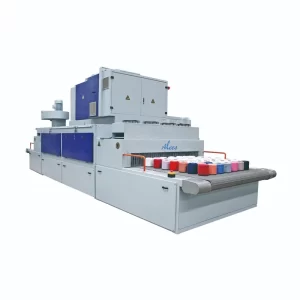
Fully Automatic Radio Frequency Dryer

Fully Automatic Radio Frequency Dryer



 Products
Products
 Martindale abrasion tester Updated
Martindale abrasion tester Updated
